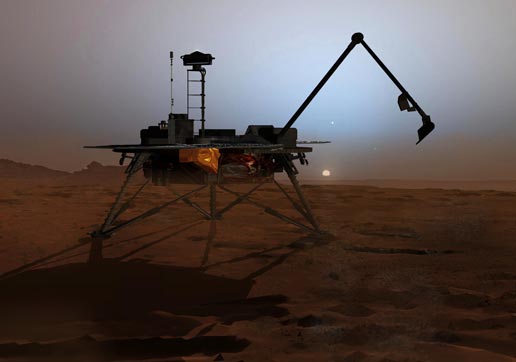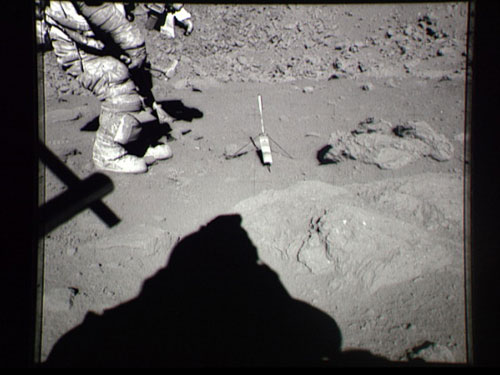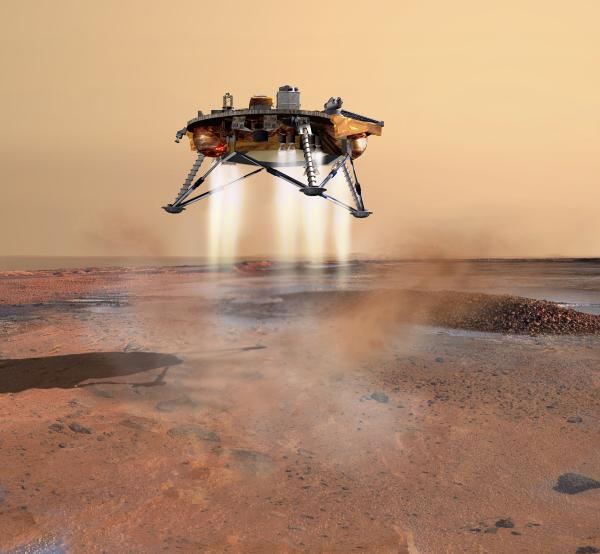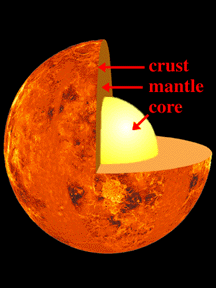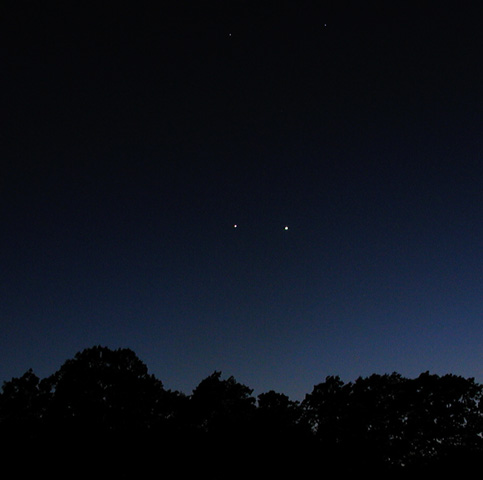
Looking for Hawking Radiation in space is likely impossible with our current technology. But scientists here on Earth recently used flowing water to simulate a black hole and create event horizons, testing Stephen Hawking’s famous prediction that the event horizon creates particles and anti-particles.
Continue reading “Looking for Black Holes in Water?”
Vatican Astronomer Says Its OK to Believe in ET
The director of the Vatican observatory said it’s possible that intelligent life exists on other planets. And since aliens would be part of God’s creation, their existence would not contradict the Catholic faith. In an interview with the Vatican newspaper Rev. Jose Gabriel Funes discussed the Big Bang theory, as well as creation and evolution. The interview was originally published in Italian, but a priest from Holland translated the full interview to English and posted it on his website, FatherRoderick.com:
Continue reading “Vatican Astronomer Says Its OK to Believe in ET”
Imminent Discovery of Life On Mars?
Do you think there is life on Mars? Do you think Phoenix will find evidence of it? Now there’s a blog that’s trying to collect a snapshot of the opinions of scientists, amateurs, and everyday people. “Imminent Discovery” thinks Phoenix may find simple life. Finding this evidence will definitely become headlines… If it happens. Is it possible it might have originated from earth? Perhaps from space, like the famous Antarctica meteorite which was believed to contain evidence of life transported here from Mars?
According to Richard Trentman, a Minor Planet Coordinator at Powell Observatory, “The idea of life in some form on other planets, I believe is highly probable. I have studied about the extreme places on this planet where life has been found and many are far more extreme than may be found on Mars and other planets or moons in our solar system. I believe that anyone that thinks life cannot be “out there” has their eyes closed and blinders on.”
Over time, many astronomers have spent a lifetime dreaming of life and formations on Mars like the misguided Slipher: “Some form of vegetation exists. …The evidence is in the blue-green areas and the changes in their appearance. Vegetation would present exactly the appearance shown, and nothing we know of but vegetation could. The season change that sweeps over them is metabolic…” And yet others take more pragmatic views like astronaut Pete Conrad who commented on bacteria surviving on retrieved Surveyor III remains: “The most significant thing we ever found on the whole Moon was that little bacteria who came back and lived an nobody ever said (anything) about it.”
What’s your opinion? Help to update the book “Imminent Discovery, NASA’s Phoenix and the Secret of Life on Mars” in a post-discovery edition with some of these inputs. Please feel free to Post Your Thoughts On The Imminent Discovery of Life On Mars. Responses may be anonymous or you may use initials if you prefer. To make it more interesting, there is a random drawing of all individuals who enter comments to give away one copy of the classic 1962 book by Earl Slipher “Mars, the Photographic Story”, and a competition between astronomy clubs. Have fun!
Phobos Might Only Have 10 Million Years to Live
You can breathe easily. The Moon is slowly receding away from the Earth at a rate of 3.7 cm/year (1.5 in/yr). But the Martians aren’t so lucky. Their moon Phobos is known to be doing exactly the opposite. It’s spiraling inward, and in the distant future it will crash into the surface of Mars. Researchers originally thought that Phobos has about 50 million years to go, but an Indian researcher has re-run the calculations and thinks Phobos only has about a quarter of that time to live.
It was originally believed that Phobos would take about 50 million years to crash into the surface of Mars, but according to Bijay Kumar Sharma, an Assistant Professor at the National Institute of Technology in Bihar, India, it might happen much more quickly. Dr. Sharma has revised the calculations for Phobos’ destruction in his new paper, Theoretical Formulation of the Phobos, moon of Mars, rate of altitudinal loss.
According to Sharma, Phobos will actually be destroyed about 10.4 million years from now, and not the 50 million years the researchers had previously calculated.
Phobos is believed to be an asteroid that Mars captured early on in its history. it’s one of the least-reflective objects in the Solar System, and thought to be similar to a D-type asteroid. It currently orbits Mars at an altitude of about 9,380 km (or about 6,000 km above the Martian surface).
Why does the Earth’s moon spiral outward, while Phobos is spiraling inward to Mars?
The Moon formed billions of years ago when a Mars-sized object crashed into Earth and sprayed material into orbit. This material pulled back together from mutual gravity to form the Moon, and this debris received a gravitational slingshot from the Earth.
They key is that the material was tossed into a high enough orbit, above what’s known as the synchronous orbit. This is where the Moon completes an orbit slower than the Earth takes to rotate once. Since the Moon ended up higher than this orbit, it’s spiraling outward. If its orbit was less than the length of a day, it would spiral inward.
And this is what has happened to Phobos. It orbits below this synchronous orbit, where it completes an orbit around Mars faster than the planet itself turns. It’s spiraling inward instead of outward.
Once Phobos gets down to an altitude of only 7000 km above the center of Mars (or 3,620 km above its surface), it will enter what’s known as the Roche limit. At this point, the tidal forces of Mars will tear Phobos apart, turning it into a ring that will continue to spiral into Mars. According to Dr. Sharma, this will happen in only 7.6 million years from now.
To know exactly how long Phobos has to live, Dr. Sharma suggests that a mission should be sent to Phobos to land on its surface and then use radar to measure the changing distance to Mars.
Original Source: Arxiv
Rising Temperatures Could Shut Down Plate Tectonics
Venus is known as the Earth’s twin, but a better name might be Earth’s “evil twin” planet. Although Venus has a similar size and mass to Earth, it has a dramatically different surface and atmosphere. And one of the biggest differences is that fact that Earth has plate tectonics, and Venus doesn’t. New research indicates that prolonged atmospheric heat might be able to shut down plate tectonics, and cause our planet’s crust to be locked in place. Don’t worry, this isn’t something we’ll have to worry about for a few hundred million years.
This research was done by scientists from the US, Canada and Australia, and published in this week’s edition of the journal Earth and Planetary Science Letters. According to the researchers, large amounts of volcanic activity or increases in the Sun’s luminosity could reach a tipping point, where the system of plate tectonics just shuts down.
Don’t worry, this isn’t an article about the dangers of global warming. The kind of temperatures we’re talking about here are beyond anything scientists are expecting from human-induced climate change.
These findings help explain why Venus might have evolved differently from Earth. Although the planet has a very similar size and geological makeup, the atmosphere on Venus is rich in carbon dioxide, and almost 100 times more dense. It acts like a blanket, trapping heat from the Sun, and raising temperatures to more than 450 °C.
Plate tectonics are very important for keeping our mild temperatures here on Earth. The carbon dioxide is pulled out of the air and trapped on the floor of the ocean. This carbon gets returned to the interior of the Earth when a free-floating sections of crust called tectonic plates slide underneath one another.
Scientists think that the Earth’s plate tectonics are stable and self-correcting, assuming excess heat from inside the Earth can escape through the crust. The flowing mantle keeps the tectonic plates moving.
But if the surface of the Earth is heated up for a long period of time, it could make the flowing mantle more viscous, so it stops flowing. This would shut down plate tectonics on Earth.
“We found the Earth’s plate tectonics could become unstable if the surface temperature rose by 38 °C (100 °F) or more for a few million years,” said lead author Adrian Lenardic, associate professor of Earth science at Rice University. “The time period and the rise in temperatures, while drastic for humans, are not unreasonable on a geologic scale, particularly compared to what scientists previously thought would be required to affect a planet’s geodynamics.”
One interesting discovery is that the rise in temperature doesn’t need to boil away the Earth’s oceans. The tectonic shut down could happen, even though there’s still liquid water on the surface of Earth.
Original Source: Rice University News Release
Lower Gravity Will Help Lunar Dust Get Deep Into Astronaut Lungs
Dusting the house might be a chore here on Earth, but when astronauts return to the Moon, they’ll need to be neat freaks. Their lives might depend on it! According to researchers at the National Space Biomedical Research Institute, the health of lunar astronauts will depend on how well they can keep the fine lunar dust out of the air.
During the Apollo lunar missions in the 1960s and 1970s, astronauts realized how much this lunar dust was a hassle to their exploration of the Moon. The tiny particles clung to everything, and when the astronauts returned to their lander, it made a real nuisance. By the end of their missions, the astronauts said there was so much dust in their vehicles that they could smell it.
There are no known illnesses associated with the dust today; but the astronauts just weren’t exposed to it long enough. But scientists studying it back on Earth found that the dust was very similar to fresh-fractured quartz, which is highly toxic to humans. When astronauts return to the Moon in the next decade, they could be on the Moon for months, and exposed to much larger quantities of the dust.
And there’s another problem. Because of the reduced gravity on the Moon, and the tiny size of the dust particles, our respiratory system might not be able to handle the particles as well as we do on Earth. Here’s Dr. Kim Prisk, an adjunct professor in the Department of Medicine at the Department of Medicine at the University of California, San Diego:
“In the moon’s fractional gravity, particles remain suspended in the airways rather than settling out, increasing the chances of distribution deep in the lung, with the possible consequence that the particles will remain there for a long period of time.”
To conduct their research, the scientists are taking participants on NASA’s Microgravity Research Aircraft. This is a special aircraft that flies on a parabolic path. At the height of each arc, people on board the aircraft experience a brief period of low gravity, or even weightlessness.
When the gravity is lowered to the same as the Moon, the participants breath in small particles, which the researchers then study as they move down the airways. They want to know how many end up in the lungs. The deeper the dust goes into the lungs, the more dangerous it’ll be.
Again, here’s Dr. Prisk:
“With the reduced-gravity flights, we’re improving the process of assessing environmental exposure to inhaled particles. We’ve learned that tiny particles (less than 2.5 microns) which are the most significant in terms of damage, are greatly affected by alterations in gravity.”
The next step will be to figure out how to limit the amount of exposure to the dust. The more dangerous the dust is, the more complicated an engineering task it will be to keep it all out.
Original Source: NSBRI News Release
It’s Almost Time for the Mars Phoenix Landing
You probably already forgot, but NASA has a spacecraft heading to Mars right now. The Phoenix Mars Lander has been traveling for almost 10 months, and it’s going to be landing on the surface of Mars in just a few days. Mark your calendar for May 25, 2008. it’s going to be an exciting day.
If everything goes according to plan, the NASA’s Phoenix Mars Lander will enter the Martian atmosphere traveling 21,000 km/hour (13,000 mph). It must then slow itself down using a variety of techniques (aerobraking, parachutes and retro-rockets), so that it can softly touch down on the surface of Mars.
Assuming the spacecraft isn’t somehow destroyed during the descent (like what happened to the Mars Polar Lander), the first signals could come back from the Mars Phoenix Lander as early as 2353 UTC (7:53 p.m. EDT).
One of the big concerns to mission planners are large boulders in the landing area. If the Mars Phoenix Lander comes right down on a boulder, it could tip over, or prevent the lander’s solar panels from opening properly. To deal with this risk, mission planners have imaged every meter of the potential landing area using the HiRISE instrument on the Mars Reconnaissance Orbiter, and haven’t found many dangerous rocks.
“We have blanketed nearly the entire landing area with HiRISE images,” said Ray Arvidson of Washington University in St. Louis, chairman of the Phoenix landing-site working group. “This is one of the least rocky areas on all of Mars and we are confident that rocks will not detrimentally impact the ability of Phoenix to land safely.”
When it finally gets down to the surface, the Mars Phoenix Lander will use its 2.35 meter (7.7 foot) robotic arm to scoop up samples of ice located underneath the ground. It has an on-board laboratory capable of analyzing the samples.
Scientists want to know of the region was ever compatible for microbial life. For example, there could be evidence that the ice freezes and melts over the course of the Martian year. This would give Martian bacteria access to liquid water. It might also be possible to find samples of carbon-based chemicals that would be the building blocks and food for life.
The mission is expected to last 3 months.
So like I said, mark your calendars. We’re less than 2 weeks away.
Original Source: NASA News Release
Does Venus Have Moons?
The quick and simple answer to ”does Venus have moons?” is No. There are no Venusian moons lurking in hidden orbits waiting to be found. Venus and Mercury are the only planets that do not have moons. There are even a few asteroids that have moons. Venus; however, may not have always been moonless.
There are a few different theories floating around to explain why Venus does not have a moon. The first is based on a series of large impacts. Some scientists think that , like Earth, Venus was impacted by a large mass asteroid or planetesimal in the early part of the history of our Solar System. The first impact would have cast a large amount of ejecta into orbit around the planet. That ejecta would have coalesced into a moon over millenia. The second stage of the theory holds that another large impact caused the planet to go into retrograde spin. The new direction of the planet’s rotation destabilized the moon’s orbit, causing it to eventually impact the surface. A similar situation is in action on Mars’s moon Phobos as we speak. That moon will impact the Martian surface in about 25 million years. This theory may have been substantiated by a 2006 study done by Alex Alemi and David Stevenson at the California Institute of Technology.
A second hypothesis holds that Venus has had moons at several points in history. Each moon would have been of varying size, but all had one thing in common: they were stolen away by the Sun. This theory is also applied to Mercury. The theory proposes that the Solar gravity is too strong and strips each planet of any moons that may have been in orbit. The solar tides destabilize the orbits of the moons and they are slowly drawn into impact courses with our star.
Asteroid 2002 VE 68 is in a quasi-orbital resonance with Venus. It is not a true moon because, while it orbits in the same time period(1:1 resonance) as Venus it has a much more elliptical orbit to the Sun, lies outside of the planet’s Hill sphere, and its orbit is unstable.
After all of the facts are in evidence, the answer to ”does Venus have moons?” is still no. The answer leaves room for the mysteries of the past to be explored. Perhaps future missions to the planet will be able to find more evidence of what happened to ancient moons around the planet.
We have written many articles about Venus for Universe Today. Here’s an article about how long it takes to get to Venus, and here’s an article about the distance from Earth to Venus.
If you’d like more information on Venus, check out Hubblesite’s News Releases about Venus, and here’s a link to NASA’s Solar System Exploration Guide on Venus.
We’ve also recorded an entire episode of Astronomy Cast all about Venus. Listen here, Episode 50: Venus.
References:
NASA Solar System Exploration on Venus
Wikipedia
What is Venus Made Of?
Venus is often called Earth’s twin planet. And when it comes to the composition, Venus is very similar to Earth. But it does have a few significant differences.
The diameter of Venus is just 650 km less than the Earth’s, and its mass is 81.5% of planet Earth.
Looking inside Venus is much harder. Here on Earth, scientists probe the structure of the Earth’s core by studying how seismic waves from earthquakes bounce off the interior of the planet. Only a few landers have reached the surface of Venus, and they didn’t last long.
Since Earth and Venus have similar size and density, scientists assume that Venus has a similar internal structure to Venus, with a core, mantle, and crust. The interior of Venus is probably at least partially liquid.
One big difference between Earth and Venus; however, is the fact that Venus has no plate tectonics. This is probably because the surface and atmosphere of Venus are so dry and hot. This reduces the amount of heat lost from the interior of the planet, and prevents it from cooling. This might also explain why Venus doesn’t have an internally magnetic field; such as the one generated by Earth.
How to Find Venus in the Sky
Venus orbits closer to the Sun than Earth, so explaining how to find Venus in the sky is pretty easy. It will be fairly close to the Sun. Venus orbits the Sun faster than the Earth so it will either appear in the sky in the West in the evening or rise before the Sun in the East.
To pinpoint the location of Venus you can use some form of planetarium software like Starry Nights or you can do it the old fashioned way and train your telescope yourself. There are a few things to consider when doing that. The first is to understand what ecliptic plane is. When you trace the path of the Sun across the sky, its path is a line called the ecliptic. The ecliptic changes slightly throughout the year. It actually rises and falls. The highest point occurs at the summer solstice, while the lowest position happens six months later at winter solstice.
Most celestial bodies are most easily observed during an elongation. An elongation occurs when an inferior(closer to the Sun) planet’s position in its orbital path is at tangent to the view from Earth. Because they are inside the Earth’s orbits their positions are never very far from the position of the Sun. When a planet is at elongation, it is furthest from the Sun as viewed from Earth, so it’s view is best at that point. There are two kinds of elongations. The Eastern Elongation occurs when the planet is in the evening sky and the Western Elongation occurs when a planet is in the morning sky. This paragraph assumes that we are talking about viewing from Earth. The apparent motion of objects in the sky due to the rotation of the Earth is 15 degrees per hour. Venus is not visible against the Sun’s background light until it is 5 degrees from the Sun, so it can not be seen until 20 minutes after sunset or before sunrise. At its greatest eastern and western elongations, Venus is between 45 to 47 degrees from the Sun and moves 3 hours 8 minutes behind or in front of the Sun. That only leaves about 2 hours and 48 minutes of observation in a given day.
Once you know how to find Venus in the sky, you will need a telescope to see anything other than a light in the sky. Also, you should have a planetary filter or off-axis mask. Still, it might be best to invest in a telescope with an automatic tracking system so that you can focus all of your attention on observing and not be constantly adjusting your scope. Good luck on your quest to observe Venus.
We have written many articles about Venus for Universe Today. Here’s are facts about Venus.
If you’d like more information on Venus, check out Hubblesite’s News Releases about Venus, and here’s a link to NASA’s Solar System Exploration Guide on Venus.
We’ve also recorded an entire episode of Astronomy Cast all about Venus. Listen here, Episode 50: Venus.
References:
http://planet-venus.net/index.php?document_id=100
http://www-istp.gsfc.nasa.gov/stargaze/Secliptc.htm

